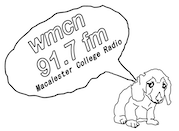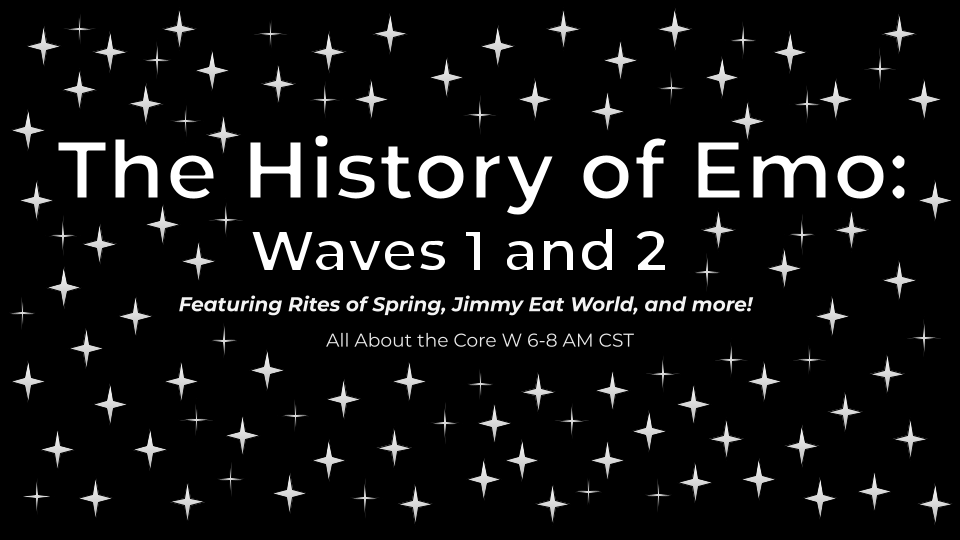An Introduction to Emocore
Emocore captivates a large fanbase because it’s an undefinable genre: its roots
trace back to hardcore, but emo songs can consist of anything from hard-hitting power
chords and solos to soft acoustic guitar. What’s the one thing they all have in common?
Introspective lyricism, and more importantly, lyrics that are sung with passion. Now,
let’s get into the history of the emo genre.
Revolution Summer: 1st Wave
Emo emerged from the hardcore scene in Washington, DC in the 1980s. Rites of
Spring, a band formed in 1984, was instrumental in the development of emo because the
lead singer, Guy Picciottoa, created a writing and vocal style that was unlike other
hardcore acts. His lyricism was focused inward and often explored more personal
subject matter in a dark manner. For example, in the Rites of Spring song “For Want
Of,” he harshly sings, “But I woke up this morning with a piece of past caught in my
throat / And then I choked.” Picciotto cleverly insinuates that he cannot “swallow” the
past, or rather, accept the truth of the past and the failures in his past relationship. This
was in stark contrast to the political subjects of many songs written by hardcore bands
at the time.
The term “emocore” was coined by Brian Baker of Dag Nasty in an interview with
Thrasher Magazine in their January 1986 issue. However, many artists in the scene
during this time despised the term and didn’t want to be associated with it. In fact, the
lead singer of Embrace, Ian McKaye, said it was “the stupidest f*cking thing [he’d] ever
heard,” adding that hardcore is already an incredibly emotional genre. Guy Picciotto
also disliked the term, stating in a 2003 interview with Mark Prindle that he’s “never
recognized ‘emo’ as a genre of music.” People in the scene preferred the label “hardcore
punk,” as they believed “emo” to be somewhat of a derogatory term, putting down artists
for being overly emotional. While the term was not welcomed by the community, the
idea behind it was clear: there was a new subgenre of rock music quickly developing,
characterized by brooding, emotional lyricism and strained, passionate singing.
McKaye and Picciotto were very influential in the development of emo’s first
wave. Embrace, Ian McKaye’s first famous band, had songs with more emotional lyrics
and singable melodies than earlier bands in the scene. For instance, in their song
Building, McKaye sings, “I can’t get what I want / I’m a failure / Nothing seems to work
out / The way I planned.” Yet in the same song, he also screams “And I can feel it
building / Failure.” The straightforward, self-deprecating lyrics give listeners a clear
sense of the despair and hopelessness he is experiencing. McKaye was also the lead
singer of Fugazi, a band which included Guy Picciotto. Other notable bands of this first
wave of emo include Beefeater and Dag Nasty.
This first wave of emo set the stage for the development of the subgenre through
its emotive lyrical expression and vocal style. Lyrics often touched on themes such as
pain, loss, anguish, and depression, which continued into other waves of emo. Vocals
were intense and passionate, with singers often straining their voices and/or screaming.
However, some sonic elements of emo changed in the next few waves, although lyrical
and vocal aspects of songs mostly remained the same.
2nd wave
In the 1990s, emo spread westward, taking a hold on the west coast and in the
midwest. Bands like Sunny Day Real Estate on the West Coast and Cap’n Jazz in the
Midwest were both instrumental in the development of this second emo wave, especially
the latter. Cap’n Jazz’s anthology album, 1998’s Analphabetapolothology, featured
distinctly passionate vocals and baffling lyrics. In their most popular song, Oh Messy
Life, Tim Kinsella sings “And you are colder than oldness could ever be / And you are
bolder than buzzing bugs.” While the lyrics are not straightforward in the slightest, it is
the intensity with which they are sung that truly gives them meaning. Furthermore,
their songs don’t follow the typical punk style with chords and distortion. As Tim
Kinsella stated in the “I Might Go To The Beach” podcast in 2017, the members didn’t
even use guitar pedals at first so that “every element could be distinctly discernible.”
After Cap’n Jazz disbanded, brothers Mike and Tim Kinsella –drums and vocals
respectively– went on to form other emo bands: American Football and Joan of Arc.
Their guitarist, Davey Von Bohlen, joined The Promise Ring. Despite not having much
in common sonically, these acts still had that prominent emotional lyricism, and thus
became hallmarks of this second emo wave.
These four bands are known not only as significant acts in this era of emo, but
also in the development of the subgenre known as midwest emo. While the subgenre’s
name comes from the geographical location of where leading bands originated from,
midwest emo is more so characterized by its leanings towards indie rock and math rock,
with captivating chord progressions, riffs, and melodies that are not as intense sonically
as with acts in the first wave or bands of the third wave. Other than “Oh Messy Life”, one
of the most noteworthy songs of this genre is “Never Meant” by American Football, off
their self-titled LP released in 1994. In this track, Mike Kinsella sings “So, let’s just
pretend / Everything and anything / Between you and me / Was never meant.” These
lyrics are much more comprehensible than in “Oh Messy Life,” and the sadness with
which they are sung, in addition to the distinctive opening riff, allow them to be put in
this subcategory of midwest emo.
Two records that were especially important in shaping the emo genre in the late
nineties were Jade Tree and Deep Elm. Deep Elm Records released The Emo Diaries
from 1997-2011. These compilations were open-submission, allowing unsigned artists to
showcase their talents to a wider audience, as emo was still mostly underground at the
time. These records featured a wide variety of music sonically and lyrically, some of
which didn’t necessarily fit into the emo genre, but still spread the emo name and
cemented it in music forever.
One major household act featured on the first volume was Jimmy Eat World, who
were signed to Capitol Records at the time. While they weren’t mainstream until their
2001 release “Bleed American” with the hit single “The Middle,” Jimmy Eat World still
played a very influential role in developing the scene into its next wave with their early
emo-pop records, such as 1999’s “Clarity.” This album featured soft, gentle, yet
emotional tracks such as “Table For Glasses,” but also heavier songs like the popular
track “Blister.” On Blister, Jim Adkins sings “And how long would it take me / to walk
across the United States all alone / The West Coast has been traumatized / And I think
I’m the only one still alive.” Like with Cap’n Jazz, these lyrics do not necessarily make
sense at first, but meaning is evoked by Adkins’ moving vocals. The song also features a
section with dual vocal melodies, a feature that has been replicated by many other emo
acts, notably Taking Back Sunday, such as in their song “Cute Without The E (Cut From
The Team.” This album exemplifies what it means to be emo: a sonically diverse
compilation of sounds that ring with emotional vulnerability and passion.
The second wave of emo is where we see the genre begin to transform into
something closer as to what most people think of as emo. Cap’n Jazz, Jimmy Eat World,
and other key acts like Weezer may not have much in common sonically, but all
contributed significantly to its development with their reflective lyricism. They laid the
groundwork for the next wave of emo to break into the mainstream, especially the latter
two bands, with their catchy melodies, and generally more upbeat yet still introspective
writing, both lyrically and musically. Only because of this wave was emo able to become
mainstream in the 2000s, making it instrumental in the genre’s growth.
In the next post I’ll cover the third and fourth waves of emo, where the genre
really breaks into the mainstream and gains more popularity and recognition!
Important bands in these waves include My Chemical Romance, Paramore, Fall Out
Boy, and Panic! At The Disco, as well as Tigers Jaw, Joyce Manor, and Modern Baseball.
Stick around and learn why emo’s not dead! See you next time!
xx,
knuckle punk



looking forward to the show this wednesday!!
Incredible work! I love you <3
pov: reading my smart friend’s blog post.. can’t wait to be on ur show on Wednesday!!!!
They need to put this on jstor